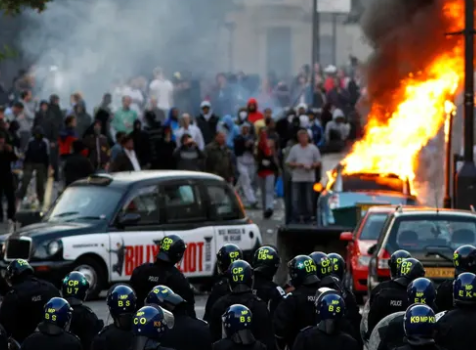Academic Hannah Awcock attended the 2010 protests as a student, and now lectures on the history of protest at the University of Edinburgh.
學者漢娜·阿考克以學生的身份參加了2010年的抗議活動,現在她在愛丁堡大學教授關于抗議的歷史。
She explained that throughout history, from the 1866 Hyde Park suffrage riots to the student demos,
她解釋說,縱觀歷史,從1866年海德公園選舉騷亂到學生示威,
protest crowds have often pushed to go further than their organisers, or the authorities, will allow for.
抗議人群往往會走得比組織者或當局允許的更遠。
And yet, as febrile as the atmosphere around Brexit and austerity has been in the nine years since the student protests and London riots,
盡管,自學生抗議和倫敦騷亂以來的9年里,圍繞英國脫歐和財政緊縮的氣氛一直很狂熱,
large protests have appeared calmer, on the face of it at least.
但是至少從表面上看,大規模的抗議活動較為平靜。
In the UK, "that really aggressive and confrontational policing that emerged post-9/11 seems to have diminished now," Awcock said.
阿考克表示,“現在在英國,911事件后出現的那種真正具有攻擊性和對抗性的警務工作,似乎已經減少了。”
"Maybe it's because the protests themselves are less radical,
“或許是抗議者本身沒有那么激進了,
but it's also because there's also been a turn towards more subtle methods of policing crowds,
但也是因為轉向了更機智的方式來管制人群,
techniques like increased surveillance and intelligence gathering."
包括加強監視和情報收集等方式。”
The changes to crowd policing in the past decade owe a great deal to behind-the-scenes policy work by crowd psychologists.
過去十年間管制人群出現的變化很大程度上要歸功于幕后的群眾心理學家做的政策工作。
Clifford Stott has worked with police and football authorities for many years to discourage heavy-handed policing.
克利福德·斯托特多年來一直與警方和足球當局合作,阻止嚴厲的警察執法。
One turning point, he told me, was the 2011 Liberal Democrat conference in Sheffield, where South Yorkshire police trialled Stott's recommendations.
他告訴我,2011年在謝菲爾德舉行的自由民主黨會議是一個轉折點,南約克郡警方在會上對斯托特的建議進行了測試。

Unlike Brighton, Liverpool, Birmingham or Manchester, the city was not used to hosting conferences for a party of government,
與布萊頓、利物浦、伯明翰或曼徹斯特不同,這座城市不習慣為政府舉辦會議,
and substantial student and anti-austerity protests were expected.
出現大量的學生和反緊縮抗議活動是意料之中的。
In preparation, police established a new "dialogue unit" of Police Liaison Teams (PLTs) in blue tabards,
在籌備工作中,警方成立了一個新的身著無袖制服的警察聯絡隊“對話組”,
recruiting individuals to move among the crowd talking to them, rather than policing in numbers from the outside.
招募個人在人群中走動,與他們交談,而不是大批地在外面管制。
"What we found was that these dialogue units were policing the police," said Stott. "
斯托特說,“我們發現這些對話組管制的是警察。”
They were stopping unnecessary interventions. The PLTs were reassuring the commanders that an intervention wasn't needed."
他們停止了不必要的介入。警察聯絡隊向指揮官保證沒有必要進行干預。
Instead of riot cops wading in, de-escalation and crowd self-regulation took over.
防暴警察沒有介入,取而代之的是沖突降級和人群自律。
Since then, Stott said, this approach has become more common.
斯托特說,自那以后,這種方法就更常見了。
"Where the police have these capacities for dialogue and communication, there's less disorder. It's that simple."
“警方有這些對話和溝通的能力,混亂就會減少。就這么簡單。”












